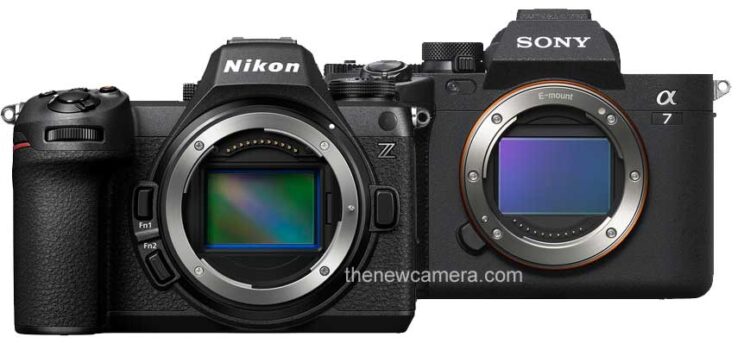
Let’s the comparison of the Nikon Z6 III camera with the Sony A7 IV starting from the design part we do have some major differences let’s find out.
The Sony A7 IV camera uses a 3.69 million-dot electronic viewfinder whereas in the latest Nikon Z6 Mark 3 camera, Nikon has introduced a flagship-level electronic viewfinder with 5.76 million resolution. Not only that, the refresh rate of this particular viewfinder is the best in its class with 120 frames per second as well as the EVF has 4000 nits of brightness units. That indicates you will experience one of the best electronic viewfinders ever introduced in a camera.
Buy Nikon Z6 III from B&H Store | amazon.com
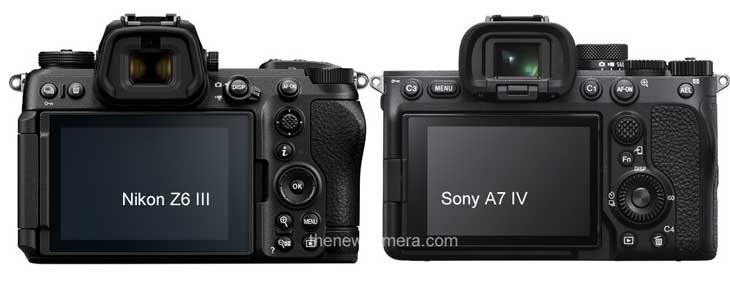
Design and Build
Electronic Viewfinder (EVF)
- Sony A7 IV: 3.69 million-dot resolution.
- Nikon Z6 Mark 3: Flagship-level EVF with a 5.76 million-dot resolution, 120 frames per second refresh rate, and 4000 nits brightness. This provides a superior viewing experience.
Now the second major advantage in the design part of the Nikon Z6 Mark 3 camera we have is the introduction of a full-size HDMI port, so that’s a really very usable tool for professional cinematographers as well as photographers. For those who work in the studio and use their camera in their workflow HDMI cable this is a highly usable upgrade.
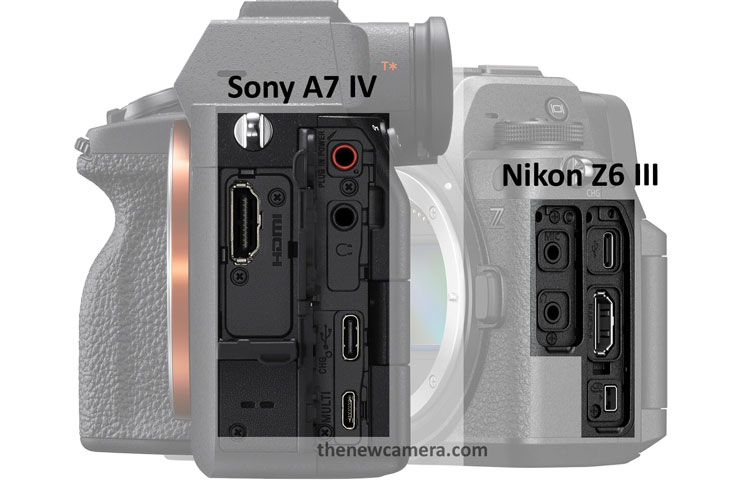
HDMI Port
- Nikon Z6 Mark 3: Features a full-size HDMI port, as well as Sony A7 IV camera, features Full Size HDMI port
Apart from these two features, the rest of the force in both the camera is almost similar. Even if we compare the display screen, the Nikon Z6 Mark 3 camera vari-angle display screen is slightly larger by 2 inches compared to the Sony A7 IV camera. Resolution-wise, the Sony A7 IV camera uses a 1.4 million-dot display unit whereas Z6 Mark 3 camera uses 2.1 million dots display unit, so even though if you compare the electronic viewfinder or the vari-angle display screen in both of the scenarios Z6 Mark 3 camera wins.
Dual vs Triple Card Slot – No Backup option in Nikon Z6 III
The Sony A7 IV camera carries 3 card slots now why do they have to put 3 different card slots in a single camera says there is no connection between a CF Express Type A card slot and an SD card slot(s), so they have to put two different sets of UHS-II SD card slot and single CF Express Type A card slot at the Sony A7 IV camera so that if you want to create a backup card then you can utilize the two different UHS-II SD card slots in a camera like you use them from DSLR time as a backup card or once the card gets overflow then the camera automatically stores in a different (SD) card so you have all the options available as you generally used the two different card slots in any other camera Pro DSLR Camera, A7 IC also has an extra CF Express to record 4K videos up to 30 frames per second without getting the camera overheated.
The biggest issue with the Nikon Z6 Mark 3 cameras is that you only have two different card slots which act as a single card slot since one is a UHS-II SD card slot and the other is a CF Express Type B card slot now none of these cards are connected so there is no way that you can create a backup card.
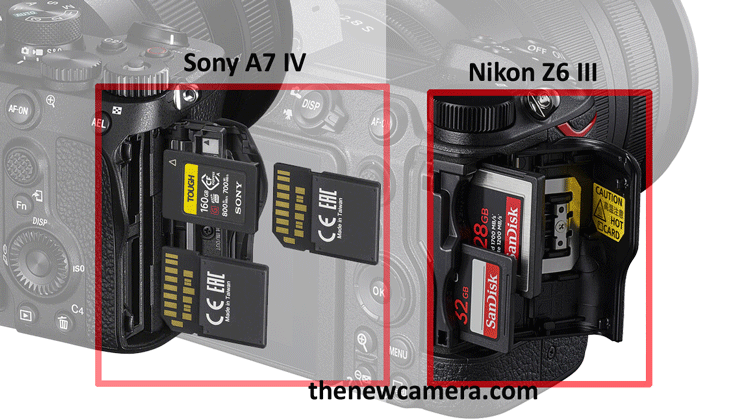
Display Screen
- Sony A7 IV: 1.4 million-dot display unit.
- Nikon Z6 Mark 3: Vari-angle display screen with 2.1 million dots, offering a clearer and larger display.
Now let’s talk about one of the biggest advantages of the Sony A7 IV camera. The Sony A7 IV camera’s battery life is twice as good as in the Z6 Mark 3. With the help of A7 IV you can capture approximately 600 shots and in Z6 Mark 3 with EN-EL 15c battery you’re limited to 380 shots, so approximately with the A7 IV camera, you are getting 220 plus shots in a single charge.
Battery Life
- Sony A7 IV: Approximately 600 shots per charge. That’s an awesome backup, just like DSLR time when u charge and forget
- Nikon Z6 Mark 3: Approximately 380 shots per charge with the EN-EL15c battery. The Sony A7 IV offers better battery life, providing around 220 more shots per charge.
Now it’s time to compare the core specifications of both cameras.
Core Specifications Difference
Sensor and Performance
- Nikon Z6 Mark 3: Newly developed 24.5MP Partially-Stacked CMOS Sensor
- Sony A7 IV: 33MP Full-Frame Exmor R CMOS BSI Sensor (Non Stacked)
Let’s start with the sensor in the latest Z6 Mark 3 camera. We have recently developed partially stacked CMOS sensor with the help of new stacked sensor the camera is able to grab continuous shooting speed up to 120 frames per second in DX mode as well as in full resolution JPEG mode you are able to capture up to 60 frames per second. At the very same time if we calculate the readout speed of the sensor then it ranges between 6.4 milliseconds to 9.4 milliseconds, so overall the readout speed of Nikon Z6 Mark 3 camera sensor is exceptionally well and you will not notice any rolling shutter effect while capturing high frame rate images in your camera. When compared to the Sony A7 IV the continuous shooting speed of the camera is limited to 10 frames per second, which is completely unethical to have such a kind of continuous shooting speed in 2024 in a camera of $2000 price range.
Nikon Z6 Mark III and the Sony A7 IV cameras: comparison of the sensor readout speeds
| Feature | Nikon Z6 Mark 3 | Sony A7 IV |
| Sensor Type | Partially Stacked CMOS | CMOS |
| Continuous Shooting Speed (DX Mode) | Up to 120 fps | Not specified |
| Continuous Shooting Speed (Full Resolution JPEG Mode) | Up to 60 fps | 10 fps |
| Sensor Readout Speed | 6.4 milliseconds to 9.4 milliseconds | 26.8 milliseconds |
| Rolling Shutter Effect | Minimal due to fast readout | More noticeable due to slower readout |
ISO Range
- Nikon Z6 Mark 3: Standard ISO range from 100 to 64,000, expandable from 50 to 204,800. 1 Stop advantage over A7 IV standard ISO range
- Sony A7 IV: Standard ISO range from 100 to 51,200, expandable from 50 to 204,800.
Not only speed when Nikon Z6 Mark 3 camera excels in low light performance and you get extra stops of ISO in this standard ISO zone. The standard ISO range of Nikon Z6 Mark 3 camera starts from 100 to 64,000 and expandable ISO range starts from 50 to 204,800 whereas in Sony A7 IV camera we have standard ISO range that starts from 100 and goes up to 51,200. The expandable ISO range is 50 to 204,800.
| Feature | Nikon Z6 Mark 3 | Sony A7 IV |
| Standard ISO Range | 100 to 64,000 | 100 to 51,200 |
| Expandable ISO Range | 50 to 204,800 | 50 to 204,800 |
| Low Light Performance | Extra stops of ISO in standard range, excels in low light | Good low light performance, but lower standard ISO range |
Base ISO Test
The resolution advantage is associated with the Sony A7 IV camera. With the Sony A7 IV camera, you can capture 33 megapixel images whereas the Z6 Mark 3 camera is limited to 24 megapixels. If you just compare the 24-megapixel sensor of the Nikon Z6 camera with the Sony A7 IV you can see that the Sony A7 IV camera with the help of a 33-megapixel sensor can extract a little bit more detail in the image when compared to a 24 MP FX-format full-frame sensor of Nikon.
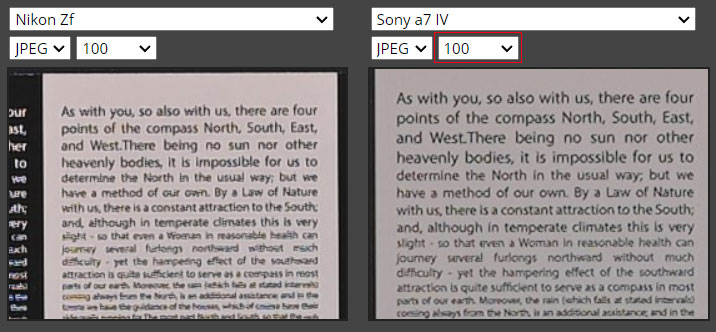
The clear advantage of a Sony A7 IV camera is that you can extract a bit more detail from a given scene, but at the very same time with the Nikon Z6 Mark 3 camera, we do have a higher resolution pixel shift mode.
PIXEL SHIFT Mode in Nikon Z6 Mark III Camera
- Sony A7 IV: 33 megapixels, providing a bit more details
- Nikon Z6 Mark 3: 24 megapixels, but features a pixel shift mode allowing for 96-megapixel images.
With the help of pixel shift mode with Nikon Z6 Mark 3 camera can capture 96 megapixels of image, but we do have a few drawbacks of pixel shift mode. The number one drawback is that the subject has to be still not moving at the very same time you have to place your camera on a tripod and overall the camera is not able to stitch the multiple-shot images you have to take out all the images, put them in a software and it will automatically stitch all together.
Sony A7R Mark IIIa as an option for Pixel Peepers
So yes if you are a high resolution sensor fan then in this particular price you can also get cameras like Fuji XT5 or maybe Sony A7R Mark 3 camera in the very same price range and both of them are approximately 40 megapixels and plus one of my personal favourite cameras is without a doubt Sony A7R Mark 3A even in 2024 so if you are a fan and you want to extract the maximum possible details available in the entire scene then you can go towards these two cameras.
Being said that the sensor does have a little bit less resolution but the low light performance and the readout speed of the Nikon Z6 Mark 3 camera is exceptionally well.
| Feature | Nikon Z6 Mark 3 | Sony A7 IV |
| IBIS Stops | 8 stops | 5.5 stops |
| Sensor-Shift IBIS | Advanced sensor-shift mechanism linked with autofocus points | Traditional sensor-shift stabilization |
| Slowest Shutter Speed Based on IBIS | Up to 8 stops slower than standard handheld speeds (approximately 1-second exposure handheld) | Up to 5.5 stops slower than standard handheld speeds (approximately 0.5-second exposure handheld) |
| Low Light Advantage | Significant advantage due to 8 stops of IBIS | Good stabilization but less effective in low light compared to Nikon Z6 Mark 3 |
Additional Features
Image Stabilization
- Nikon Z6 Mark 3: Advanced in-body image stabilization (IBIS) system, offering 8 stops of IBIS. The IBIS is connected to the autofocus points, Advanced AI IBIS algo inside the camera.
- Sony A7 IV: Traditional IBIS system with 5.5 stops of stabilization, not linked to autofocus points.
Now Nikon Z6 Mark 3 camera has an additional advantage for shooting in low light. You already have a low light sensitive full-frame CMOS sensor in construction Mark 3 camera which now pairs up with highly advanced in-body image stabilization system.
The Nikon Z6 Mark 3 camera image stabilization system is coming straight out from Nikon ZF camera. The camera is having 8 stops of IBIS sensor-shift mechanism and one of the most advanced things is the sensor-shift image stabilization system is directly connected with the autofocus point of the camera so as the autofocus point of your camera moves in the frame the sensor-shift image stabilization also shifts and gives you 8 stops of IBIS experience. If you compare with the Sony A7 IV camera sensor-shift stabilization system then it limits to 5.5 stops and it’s kind of traditional IBIS so it is not linked with the points and all that stuff.
Conclusion – Best Camera for Photographers
While the Sony A7 IV offers better battery life and higher resolution, the Nikon Z6 Mark 3 excels in low-light performance, viewfinder quality, display resolution, and continuous shooting speed. The Z6 Mark 3’s advanced HYBRID stabilization system and full-size HDMI port also make it a strong contender for professional use.
Make your Decision on these two FACTORS
1. The Requirement you have for your next camera
2. The Budget Range You Have
TNC Recommendation and Overall Best Camera for Photographers
Nikon Z6 Mark III camera features class-leading core specification and very reasonable price point, I recommend the Nikon Z6 Mark III over the Sony A7 IV camera, the A7 IV now needs an update and lets hope and expect the Sony A7 V will beat the Nikon Z6 III in terms of its core specification as well as price.
If, your requirement is less, you mostly shoot weddings, events, nature, Landscape, or Even portraits and you feel having a bit more details in your image will help you to capture shot with more details, then for sure the Sony A7 IV camera is more recommended to you.
SUPPORT US | Buy Nikon Z6 III from B&H Store | amazon.com









Nikon Z6 III does have all the features of my wish list
@admin on a trip?
“Nikon Z6 Mark 3: Features a full-size HDMI port, Compared to Micro HDMI Port of the Sony A7 IV“
The A7IV does have a full-size HDMI port! 🤷🏻♂️
@Roger1 Thanks, we have fixed it
Wow! Great In-Depth Analysis! Thank you for this!